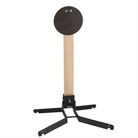Opinion
“Overly-confident conjecture, ‘backed-up’ by fictional data” ~ Paul Harrell.
Tactical Exorcism!
I routinely hear from beginning firearms students any number of fairy tails that circulate among those who are new to our Art.
Some professing instructors, who are in the process of trying to manufacture an “instant reputation,” put out pretty outlandish nonsense, mostly, I think, just so that they can “get noticed”
Conversely, most of what we legitimately teach is not particularly glamorous nor eccentric, so sound doctrine often does not achieve the profile enjoyed by breathtaking new theories, the vast majority of which are quickly (and mercifully) forgotten.
Here is one I’ve encountered lately:
“Jack Weaver developed and used his signature stance, only because one of his arms was shorter than the other!?”
Yes, and Jack also had three eyes and a tail!
Jack died in 2009 at the age of eighty. I never met him personally, but I did meet and know many of his contemporaries. And, although the “Weaver Stance” bears his name, people were shooting from a stance that looked pretty similar decades before.
Jack liked his particular interpretation because his pistol was held close to his body, and he could thus pivot more quickly than if it were further out. Jack also liked the idea that his stance was resistant to forcible disarms, again because the pistol was close to the body.
Of course, the closer the pistol gets to the sighting eye, the more coarse the sight picture, assuming one is using conventional iron sights.
With the Isosceles Stance (that so far no one has ever stepped forward and claimed to have “invented”), the pistol is further away from the face and hence more inherently accurate, again assuming iron sights.
However, Jack knew, as we do, that the degree of relative “enhancement” or “degradation” of accuracy between the two stances was minuscule and thus irrelevant for most “serious uses” of pistols.
Such accuracy disparity was of interest only to competitors who often shot at very small targets, and what distinguished the tournament’s “winner” from the next dozen competitors was a tiny oval (the “X-Ring”).
And, since Jack was more interested in legitimate gun-fighting skills and tactics than in quaint competitions, he preferred the “Weaver Stance,” as I do, and for the same reasons.
Today, both the Weaver Stance and the Isosceles Stance are perfectly legitimate, and both have their advocates.
In fact, with the advent and popularity of pistol optics (replacing traditional iron sights), reasons for preferring one stance over the other are even less persuasive!
So, the “short-arm theory” is one we can happily exorcize from our Art.
“When legend becomes ‘fact,’ print the legend” ~ Newspaper publisher, Maxwell Scott (played by Carleton Young), in the 1962 feature film, “The Man Who Shot Liberty Valance,” starring John Wayne, Jimmy Stewart, and Lee Marvin
/John
Read Related: Pistol Shooting Positions: Weaver Vs. Isosceles
About John Farnam & Defense Training International, Inc
As a defensive weapons and tactics instructor, John Farnam will urge you, based on your beliefs, to make up your mind about what you would do when faced with an imminent lethal threat. You should, of course, also decide what preparations you should make in advance if any. Defense Training International wants to ensure that its students fully understand the physical, legal, psychological, and societal consequences of their actions or in-actions.
It is our duty to make you aware of certain unpleasant physical realities intrinsic to Planet Earth. Mr. Farnam is happy to be your counselor and advisor. Visit: www.defense-training.com

Live Inventory Price Checker

|
Steel Handgun Targets With Heavy Base - Steel Ipsc Torso Handgun Target With Heavy Base | Brownells.com | $ 260.00 |
|

|
Steel Handgun Targets With Heavy Base - 8'''' Steel Handgun Training Target With Heavy Base & Holder | Brownells.com | $ 290.00 |
|

|
Steel Handgun Targets With Standard Base - Steel Torso Shaped Handgun Target With Standard Base | Brownells.com | $ 240.00 |
|

|
Steel Handgun Targets With Heavy Base - 10'''' Steel Handgun Target With Heavy Base | Brownells.com | $ 225.00 |
|






It would be virtually impossible to find someone whose arms are absolutely equal in length. Even if they were unequal by inches, the shooter could easily shift position of the feet to adapt to the “shortcoming,” if one really wanted to use isosceles.
Weaver knew exactly what he was doing, and so do I when I use the excellent stance he developed.
While in my first 8 week POST course many decades ago we had a FBI agent teaching the firearms portion. At that time we all were using revolvers.
After I shot a perfect 300 on the PPC qualifier He said he it didn’t really count because I used speed loaders and a Weaver stance.
When I became state certified firearms instructor. I always said I don’t care what stance you use. As long as your shooting and the hitting the target properly.
But if your not we well have a talk.
I shoot a modified Weaver these days.
“both the Weaver Stance and the Isosceles Stance are perfectly legitimate, and both have their advocates.”
Why must it be one or the other? Why can’t we use either/or, depending upon the situation? I, personally, use the Weaver for close range and better recoil control, and the Isosceles for better accuracy when that is what the situation calls for.
I was taught modified Weaver at Front sight, and still use it in all my practice. Hopefully, if the need arises, I will use something like it in a serious situation. But as long as you can keep control of your weapon and land rounds on the target, any stance will do. Lol at the short arm story.